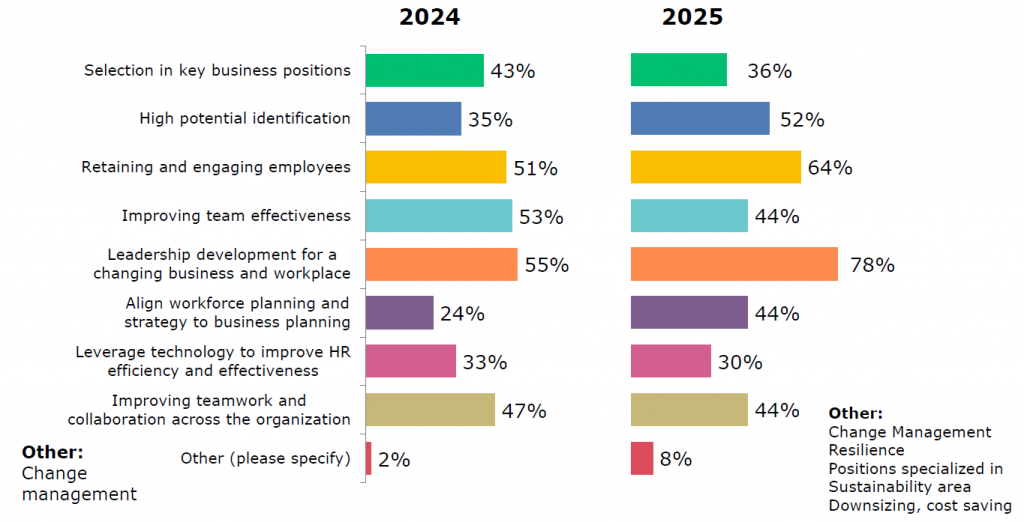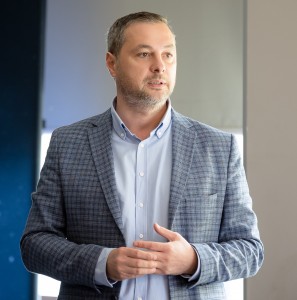HR in 2025: Leadership, Talent, and the Strategies That Matter
Postat de admin la 11 Feb, 2025 in categoria LeadershipAt the end of last year, Hart Consulting conducted a comprehensive survey among its clients to identify the most critical priorities on HR’s strategic agenda for 2025 compared to 2024.
Key Findings and Emerging Trends
Our analysis of the data revealed several significant trends that highlight the evolving role of HR as a strategic driver of organizational performance and adaptability:
1. Leadership Development for a Changing Business and Workforce remains the top priority. An overwhelming 78% of respondents ranked this as their primary focus for 2025, marking a 23% increase compared to 2024, when it was already a leading concern. Leadership development is widely recognized as essential for executing business strategy amidst uncertainty, cultivating a resilient organizational culture, and ensuring employee well-being and productivity at all levels.
2. Employee Retention and Engagement has climbed to second place on HR’s 2025 agenda, demonstrating a 13% increase in importance compared to 2024. Previously ranked third, this priority is closely followed by Improving Team Effectiveness, another critical area of focus.
3. Identifying High-Potential Employees has emerged as the third most important priority for organizations in 2025, reflecting the growing necessity of developing robust leadership pipelines.
4. Aligning Workforce Planning and Strategy to Business Needs has experienced the second-largest increase in significance compared to 2024, rising by 20%. This shift underscores the increasing emphasis on integrating HR strategies with overarching business objectives.
5. Recruitment Efforts Are Expected to Decline in 2025 relative to 2024. This trend suggests a strategic shift toward internal talent optimization, emphasizing workforce planning and alignment rather than aggressive external hiring.

Expert Perspectives on HR Priorities in 2025
To further explore these trends, we invited experienced HR professionals and industry leaders to share their insights on the evolving talent agenda for 2025.
The Shift in Recruitment Strategies
 Observing the slowdown in recruitment, Florin Dulgheru (Senior HR Director, Apa Nova) notes that companies are exercising greater caution in hiring decisions. He attributes this to economic uncertainty, concerns about a potential recession, technological advancements, and cost optimization pressures. Organizations are taking more time to ensure a strong fit for roles rather than filling positions as quickly as possible. Additionally, there is a clear preference for retaining and upskilling existing employees over external hiring.
Observing the slowdown in recruitment, Florin Dulgheru (Senior HR Director, Apa Nova) notes that companies are exercising greater caution in hiring decisions. He attributes this to economic uncertainty, concerns about a potential recession, technological advancements, and cost optimization pressures. Organizations are taking more time to ensure a strong fit for roles rather than filling positions as quickly as possible. Additionally, there is a clear preference for retaining and upskilling existing employees over external hiring.
 Cătălina Magui (HR Director, Societe Generale – Global Solution Centre) highlights a broader shift in mindset: “The ‘let’s grow’ mentality is being replaced by ‘let’s do better, faster, and easier.’ This signals a strategic focus on continuous improvement through learning, reskilling, and adapting to evolving business conditions.”
Cătălina Magui (HR Director, Societe Generale – Global Solution Centre) highlights a broader shift in mindset: “The ‘let’s grow’ mentality is being replaced by ‘let’s do better, faster, and easier.’ This signals a strategic focus on continuous improvement through learning, reskilling, and adapting to evolving business conditions.”
 Conversely, Mădălina Uceanu (Managing Partner, Career Advisor) believes this recruitment slowdown is temporary: “Once companies reassess their strategies, hiring will regain momentum. Additionally, rapid technological advancements require adjustments in workforce planning.” She also notes that current discussions tend to focus more on jobs lost due to AI rather than the opportunities it creates.
Conversely, Mădălina Uceanu (Managing Partner, Career Advisor) believes this recruitment slowdown is temporary: “Once companies reassess their strategies, hiring will regain momentum. Additionally, rapid technological advancements require adjustments in workforce planning.” She also notes that current discussions tend to focus more on jobs lost due to AI rather than the opportunities it creates.
The Future of Jobs Report 2025, published by the World Economic Forum, reinforces this perspective. While AI-driven transformation is expected to eliminate 92 million jobs, it is also projected to create 170 million new roles, resulting in a net gain of 78 million jobs by 2030.
Leadership: The Cornerstone of Organizational Success
In 2025, the importance of effective leadership remains paramount as companies navigate an increasingly complex and dynamic business landscape.
Florin Dulgheru emphasizes that “strong leaders are essential for guiding organizations through volatility, uncertainty, complexity, and ambiguity (VUCA). They are the driving force behind employee engagement, retention, and the development of an innovative and high-performance culture.” His company employs several key leadership development practices, including personalized development plans, feedback-driven culture, and customized leadership programs.
Mădălina Uceanu asserts that investing in leadership and people development should be a top priority for CEOs, particularly in an economic environment still impacted by inflation and financial pressures.
Similarly, Cătălina Magui underscores that leaders are pivotal in balancing efficiency with innovation while challenging traditional business norms.
Enhancing Teamwork and Collaboration
The importance of teamwork and collaboration remains a critical focus area for HR professionals in both 2024 and 2025.
Florin Dulgheru outlines his company’s approach to fostering strong teams: “We emphasize clear and transparent communication, well-defined goals and responsibilities, trust-building initiatives, team-building activities, fair recognition and rewards systems, and robust diversity and inclusion (D&I) programs.”
Mădălina Uceanu highlights the lingering impact of remote and hybrid work on team dynamics: “We are still experiencing the effects of prolonged isolation—first due to the pandemic and now due to hybrid and remote work arrangements. In this new reality, collaboration is once again emerging as a differentiator between successful and underperforming organizations. However, re-establishing a culture of cooperation is a gradual process that requires deliberate effort.”
Cătălina Magui echoes this sentiment, emphasizing that collaboration is a core value at SG GSC. “We are implementing structured team objectives, cross-functional projects, and knowledge-sharing frameworks to sustain motivation and enhance organizational performance.”
Identifying and Developing High-Potential Employees
Recognizing and cultivating top talent remains a strategic imperative for organizations in the current business climate.
Florin Dulgheru notes that his company leverages Hogan assessments alongside performance evaluations, project-based challenges, goal-setting initiatives, succession planning, and individualized development programs to identify and nurture high-potential employees.
At Societe Generale – Global Solution Centre, Cătălina Magui highlights a structured approach to talent management: “We align our knowledge domains with business needs, track HR key performance indicators related to top talent retention and closely monitor compensation and benefits structures. Our mentoring programs have been in place for two years, fostering knowledge-sharing, developing high-potential employees, and promoting continuous learning and career growth.”
Conclusion
Madalina Balan, Managing Partner at Hart Consulting, considers that the HR landscape in 2025 is defined by a shift toward strategic workforce planning, leadership excellence, and internal talent optimization. Organizations are moving away from traditional recruitment practices and instead focus on developing their existing workforce through learning, reskilling, and high-potential identification.Moreover, Robert B. Kaiser’s concept of versatile leadership is particularly relevant in this context, as leaders must adapt their approach to fit shifting circumstances, balancing both strategic direction and operational execution, both enabling and forceful approaches. Additionally, effective management of leadership derailments—where leaders struggle to cope with uncertainty and complexity—is crucial for ensuring long-term resilience and organizational stability.”
As businesses continue to navigate economic uncertainty and rapid technological change, effective leadership remains the cornerstone of success. By fostering a culture of engagement, collaboration, and continuous development, organizations can build a resilient workforce capable of driving innovation and long-term growth.
In an era of unprecedented transformation, one thing remains clear: the organizations that invest in their people today will be the ones shaping the future of work tomorrow.









